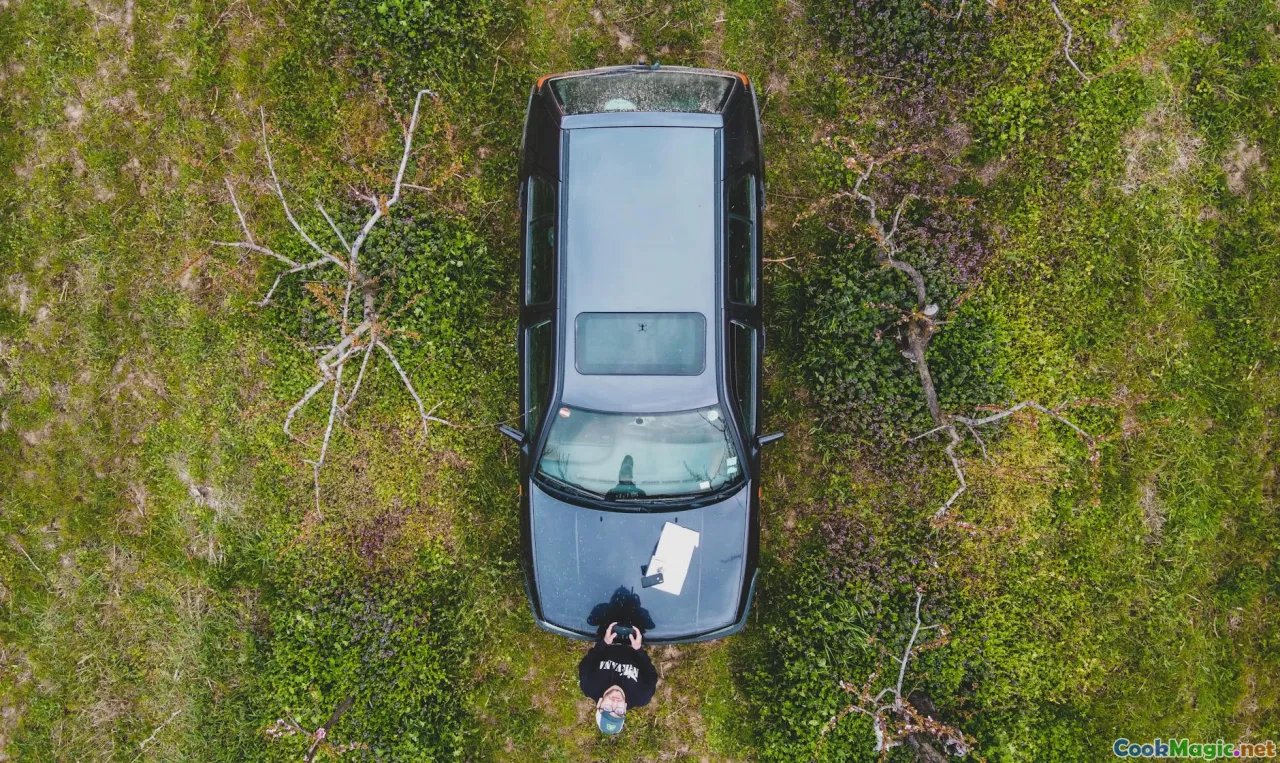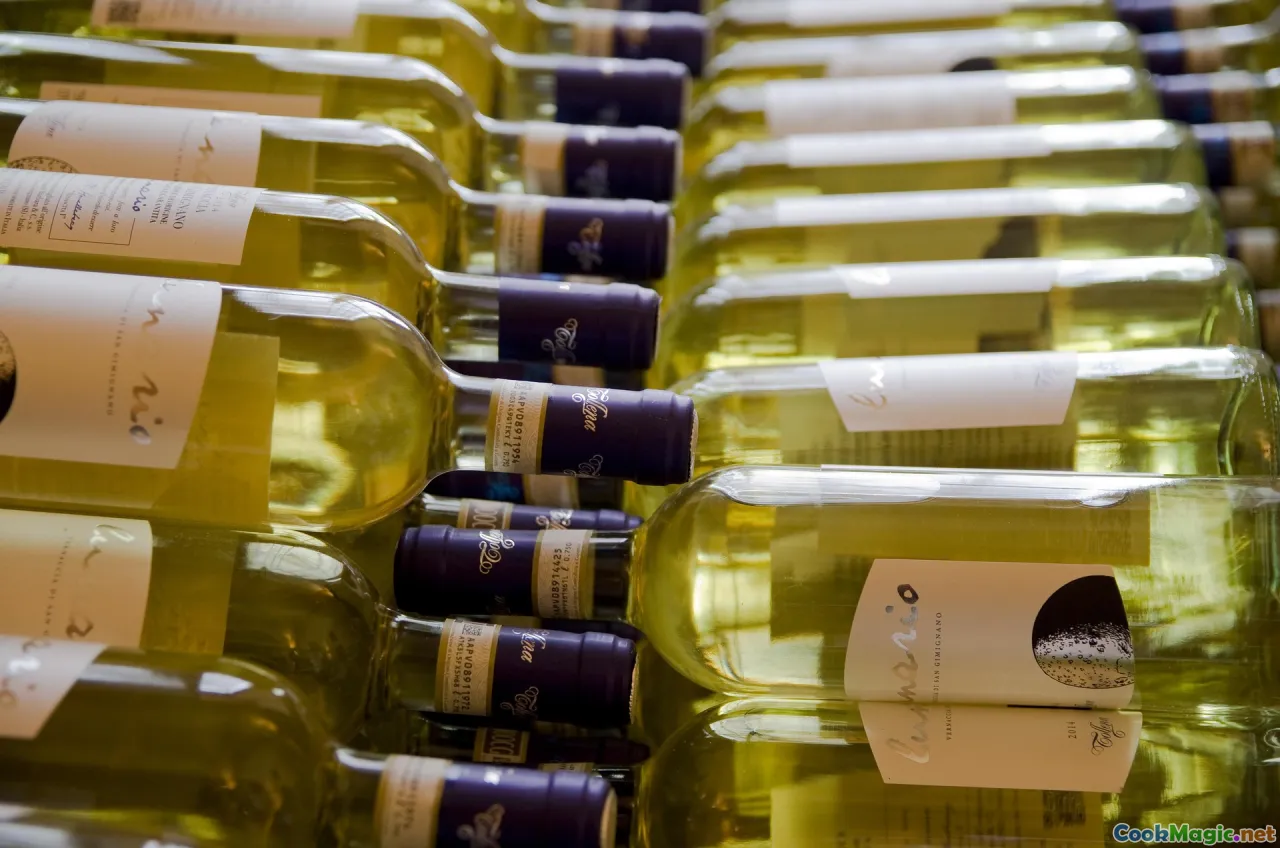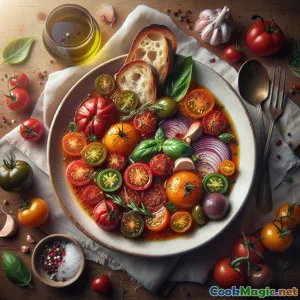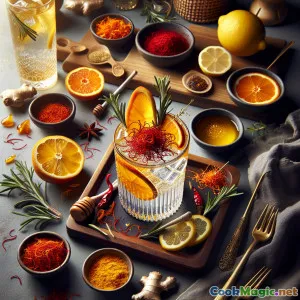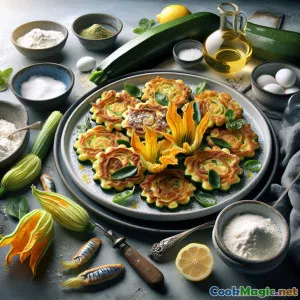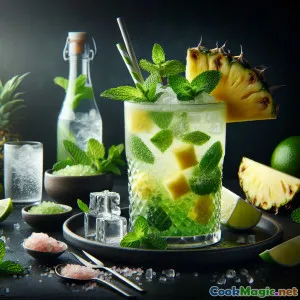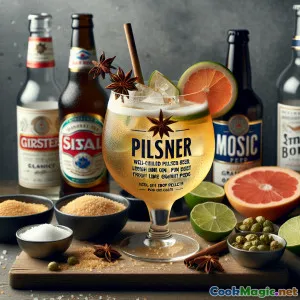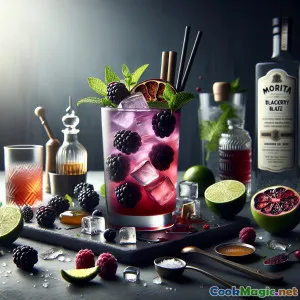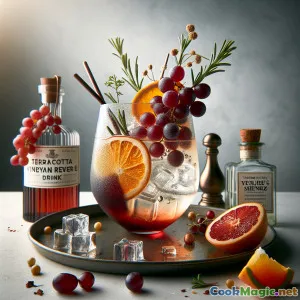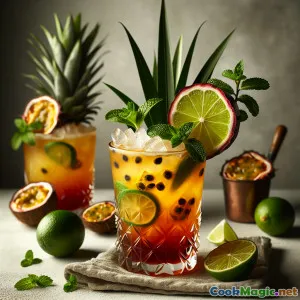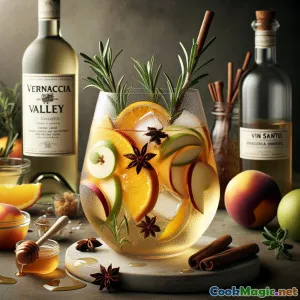
Sangria do Vale Vernaccia Toscano com Cítricos
(Vernaccia Valley Tuscan Citrus Sangria)
(0 Avaliações)0
160
outubro 09, 2025
Reportar um problema
Ingredientes
-
750 ml Vernaccia di San Gimignano vinho branco
(Chilled; dry, citrusy DOCG white from Tuscany)
-
1 each Laranja
(Thinly sliced; blood orange if in season)
-
1 each Limão
(Zest first, then slice for extra aroma)
-
1 each Pêssego
(Ripe yellow peach, sliced)
-
1 each maçã verde
(Crisp variety like Granny Smith, thinly sliced)
-
2 sprigs Alecrim fresco
(Lightly bruised to release oils)
-
2 tbsp Mel de Acácia
(Tuscan acacia honey preferred for delicate sweetness)
-
30 ml Suco de Limão Fresco
(Espremido na hora para brilho)
-
60 ml Vin Santo
(Optional Tuscan dessert wine adds nutty depth)
-
250 ml Água com gás
(Well-chilled; add just before serving)
-
3 cups Cubos de Gelo
(Large, clear cubes minimize dilution)
-
1 each Anis-estrelado
(Adds a whisper of spice; remove before serving if strong)
(Chilled; dry, citrusy DOCG white from Tuscany)
(Thinly sliced; blood orange if in season)
(Zest first, then slice for extra aroma)
(Ripe yellow peach, sliced)
(Crisp variety like Granny Smith, thinly sliced)
(Lightly bruised to release oils)
(Tuscan acacia honey preferred for delicate sweetness)
(Espremido na hora para brilho)
(Optional Tuscan dessert wine adds nutty depth)
(Well-chilled; add just before serving)
(Large, clear cubes minimize dilution)
(Adds a whisper of spice; remove before serving if strong)
Nutrição
- Porções: 6
- Tamanho da Porção: 1 copo (200 ml)
- Calories: 185 kcal
- Carbohydrates: 0 g
- Protein: 1 g
- Fat: 0 g
- Fiber: 1 g
- Sugar: 14 g
- Sodium: 15 mg
- Cholesterol: 0 mg
- Calcium: 25 mg
- Iron: 0.4 mg
Instruções
-
1 - Chill and prep:
Chill a 2-liter pitcher and all liquids. Rinse and dry fruit. Zest the lemon lightly, then slice the lemon and orange into thin rounds. Slice peach and apple.
-
2 - Macerate the fruit:
In the chilled pitcher, combine orange, lemon, peach, apple, and rosemary. Add acacia honey and fresh lemon juice. Gently muddle 3–4 presses to blend and draw out juices.
-
3 - Add wine and optional Vin Santo:
Pour in Vernaccia and, if using, Vin Santo. Stir gently until honey dissolves completely. Add the star anise if you enjoy a light spiced note.
-
4 - Infuse in the fridge:
Cover and refrigerate for at least 2 hours to marry flavors. For brighter fruit texture, do not exceed 6 hours.
-
5 - Finish and balance:
Remove star anise if used. Add ice cubes to the pitcher. Top with sparkling water and stir once or twice to integrate without knocking out bubbles.
-
6 - Garnish and Serve:
Divide fruit and liquid among glasses. Garnish with a fresh rosemary tip or citrus wheel. Taste and adjust with a drizzle of honey or extra sparkling water.
Chill a 2-liter pitcher and all liquids. Rinse and dry fruit. Zest the lemon lightly, then slice the lemon and orange into thin rounds. Slice peach and apple.
In the chilled pitcher, combine orange, lemon, peach, apple, and rosemary. Add acacia honey and fresh lemon juice. Gently muddle 3–4 presses to blend and draw out juices.
Pour in Vernaccia and, if using, Vin Santo. Stir gently until honey dissolves completely. Add the star anise if you enjoy a light spiced note.
Cover and refrigerate for at least 2 hours to marry flavors. For brighter fruit texture, do not exceed 6 hours.
Remove star anise if used. Add ice cubes to the pitcher. Top with sparkling water and stir once or twice to integrate without knocking out bubbles.
Divide fruit and liquid among glasses. Garnish with a fresh rosemary tip or citrus wheel. Taste and adjust with a drizzle of honey or extra sparkling water.
Mais sobre: Sangria do Vale Vernaccia Toscano com Cítricos
Vernaccia Valley Sangria: A Tuscan Ode to Sunshine
Vernaccia Valley Sangria is a playful, elegant riff on the beloved Iberian pitcher drink, reimagined with the soul of Tuscany. Instead of the typical red wine base, this version leans into the crisp, citrus-forward clarity of Vernaccia di San Gimignano—Italy’s storied white wine with roots that reach back to the Middle Ages. The wine’s naturally brisk acidity, notes of lemon peel, green apple, and white flowers, and its mineral backbone make it a perfect canvas for fresh fruit and herbs without losing its identity.
Why Vernaccia Works
Sangria thrives on balance—fruitiness, acidity, gentle sweetness, and a refreshing sparkle. Vernaccia brings the acidity and lean structure, keeping the drink lively even after maceration. Where softer whites might fade into sweetness, Vernaccia stands tall, letting acacia honey softly round the edges while rosemary contributes a piney Tuscan perfume that whispers rather than shouts. A splash of Vin Santo (optional) adds a subtle nutty-late-harvest complexity, like sunshine lingering at dusk.
Flavor Profile
- Nose: Lemon blossom, rosemary oils, faint anise, and sweet stone fruit.
- Palate: Zesty citrus, crisp apple, juicy peach, gentle honeyed mid-palate, and a mineral, clean finish.
- Finish: Dry, refreshing, with a light herbal echo.
Tips & Techniques
- Maceration matters: Give the fruit at least 2 hours to infuse, but avoid more than 6 hours for the brightest texture and color. Over-long infusions can lead to pithy bitterness from citrus.
- Honey strategy: Dissolve honey in lemon juice before adding wine so it integrates quickly without over-stirring, which could knock carbonation from the sparkling water.
- Ice intelligence: Large, clear cubes chill efficiently and dilute more slowly. If serving outdoors, freeze some Vernaccia into cubes to maintain intensity.
- Herbal calibration: Rosemary can dominate. Lightly bruise the sprigs and taste during infusion. Remove if it overtakes the citrus.
- Effervescence timing: Add sparkling water right before serving for a lively finish. If you prefer a stronger drink, reduce or omit the topper.
- Sweetness balance: Start with the recipe’s honey, then adjust in-glass. The fruit’s ripeness can vary considerably by season.
Ingredient Notes and Swaps
- Wine: Vernaccia di San Gimignano is the star. If unavailable, choose a dry, high-acid Italian white like Vermentino or Pecorino. Avoid heavily oaked whites.
- Fruit: Peach and apple complement Vernaccia’s orchard notes. In winter, try pear and a touch of bergamot peel. In late summer, white nectarine is lovely.
- Sweetener: Acacia honey is delicate and floral. Replace with simple syrup if you need vegan alternatives, or wildflower honey for a bolder profile.
- Aromatics: Star anise is optional; use a half pod for just a whisper. Alternatively, a paper-thin slice of fresh ginger adds lift.
Make-Ahead and Serving
- Make-ahead: Combine fruit, honey, and lemon juice up to 6 hours ahead with the wine. Keep chilled and add sparkling water and ice at the last minute.
- Scaling: For parties, double the recipe in a cold punch bowl. Float a large ice block formed in a loaf pan to slow dilution.
- Food pairings: Salumi and pecorino, grilled shrimp with lemon and herbs, panzanella, or tomato-basil bruschetta. The sangria’s minerality complements briny and fresh flavors.
Cultural Notes
Sangria is Spanish by birth, but the aperitivo culture of Italy welcomes adaptation grounded in local terroir. Tuscany’s culinary rhythm prizes simplicity—few ingredients of high quality—so swapping in Vernaccia and Tuscan pantry staples like acacia honey and rosemary feels both respectful and regionally expressive. Think of this drink as a summer postcard from San Gimignano’s medieval towers: sunlit stone, cypress shadows, and citrus caught in a sea breeze.
Responsible Enjoyment
At around one standard drink per serving (varying with pour size and whether you add Vin Santo), this is designed for relaxed sipping. Offer a zero-proof variant by replacing wine with a dealcoholized white, adding an extra 30 ml lemon juice, and using a splash more sparkling water. Keep the fruit and herbs the same for a familiar aromatic profile.
Troubleshooting
- Too sweet? Add more sparkling water and a squeeze of lemon. A pinch of salt can brighten and balance.
- Too bitter? Remove citrus peels earlier; swap rosemary for mint in future batches.
- Too flat? Ensure all components are very cold and use fresh, effervescent sparkling water at service.
Final Thoughts
Vernaccia Valley Sangria is more than a twist; it’s a conversation between traditions. It invites the freshness of Tuscan hillsides into a format built for sharing—bright, clean, and effortlessly convivial. Serve it where laughter lingers and the evening seems to stretch like gold over vineyards.

